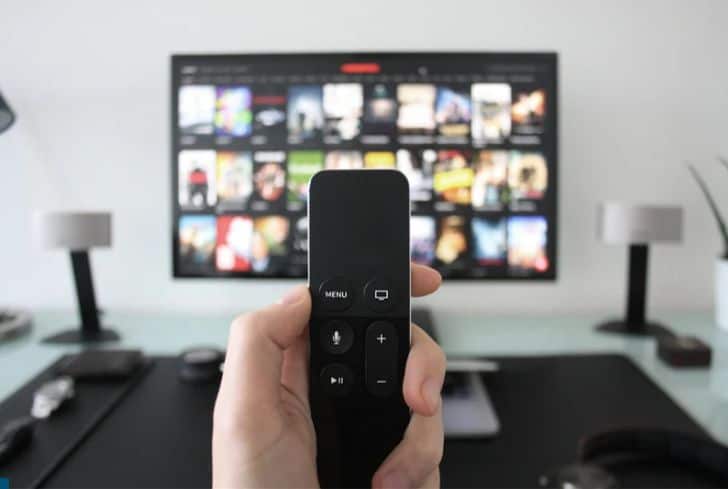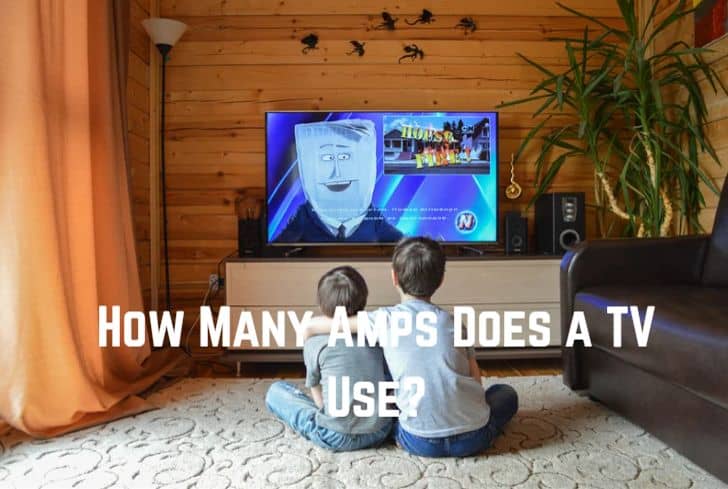TVs are a popular appliance we all want to put in our homes. Initially, they were for just watching your favorite shows.
But now they’ve become so much more than that.
You can use them to play video games, browse the internet, and stream movies — and that’s not all yet!
But, amidst all these new functionalities, one question lingers — how many amps does a TV use?
Well, I did some research and have put all my findings in this article. Herein, I’ll provide all the low-down you need about the electricity usage of televisions. I’ll even provide some tips on reducing your TV’s power consumption.
Let’s get started!
Read: How Many Amps Does a Refrigerator Use?
How Many Amps Does a Television Use?
The number of amps a television uses depends on the screen size, the type of TV, the individual settings, and other factors. But if you have the average American TV size of 50 inches, expect it to use an average of 0.9 amps at 120 volts, assuming that the settings are at their default.
TVs are among the household appliances that have evolved much since their invention. New features require more power to run, but at the same time, new technologies make TVs more energy-efficient.
And usually, we don’t have a specific number of amps that cuts across all TVs. So, the exact power usage varies from one model to another.
That’s why you may find a 50-inch Samsung TV having a wattage of 135 while the same size from TCL has as low wattage as just 79W!
Those are just two of the most common TV brands in the market. And as you can see, even with the same screen size, there’s a big difference in power usage. So, different factors affect the electricity consumption of a TV.
Fortunately, you can easily check the wattage rating of your TV. Usually, the manufacturer indicates it on the side or back of the TV. An alternative source for this information is the product manual.
Once you have information about the wattage, you can easily calculate the amperage, but more of that will come in one of the below sections.
How Many Amps Does a 55-Inch TV Use?
The number of amps a 55-inch TV uses varies from model to model and brand to brand. But on average, a 55-inch TV uses around 0.98 amps at a 120-volt power outlet and half as much with a 240-volt outlet.
A 55-inch TV will generally use more power than a 50-inch model since a more extensive screen requires more energy. A bigger screen means that a larger surface area must be illuminated, requiring more electricity.
I have summarized the average wattage of different 55-inch TVs in this table. It compares the wattage of LED, OLED, and LCD TVs.
| 55-Inch TV type | LED | OLED | LCD |
| Wattage | 80 | 100 | 175 |
| Average Wattage | 118 watts |
As you can see, the average wattage of the three types is 118 watts. That translates to about 0.98 amps when connecting it to a 120-volt outlet and 0.49amps, assuming you use the 240-volt power outlet.
How Many Amps Does a 65-Inch TV Use?

The average number of apps a 65-inch TV uses is 1.24 amps at 120 volts and 0.62amps at 240 volts. But again, 1.24 is just an average, so your TV may use more or less. So, check the wattage on your TV for accurate amperage.
A 65-inch is larger than both a 55-inch and 50-inch screen size. So, if you compare a 65-inch LED TV with a smaller one of the same brand and type, the bigger one will be more power-intensive. That’s pretty obvious, considering the surface area of the screen.
But again, the type of screen matters, too. So, an LED TV will use way less power than an LCD or OLED TV of the same screen size.
Let’s compare the three common TV types and see the power consumption for 65-inch screens.
| 65-Inch TV type | LED | OLED | LCD |
| Wattage | 100 | 120 | 225 |
| Average Wattage | 148 watts |
The table shows that the average wattage of a 65-inch TV is 148 watts. That’s 1.24 amps when using the TV with the standard 120-volt outlet and 0.62 amps if you go by a 240-volt outlet.
How Many Amps Does a 70-Inch TV Use?
A 70-inch TV will pull about 1.4 amps on average when connected to a 120-volt outlet. The larger screen and other components require more electricity than smaller models, which causes a slight difference in amps between a 65 and 70-inch TV.
As usual, let’s compare the three types of TVs with each other to see which one uses more power and how I drove the 1.4-amp number.
| 70-Inch TV Type | LED | OLED | LCD |
| Wattage | 109 | 130 | 250 |
| Average Wattage | 163 Watts |
It’s evident that power intensity follows the same order as the previous two tables. So, a 70-inch LED TV uses the least power on average, while an LCD TV of the same size is the most power-hungry. After calculating the average wattage, it turned out that an average 70-inch TV should have a wattage in the area of 163 watts.
Amps, Watts, and Cost of Different Size TVs
Now that we know how many amps each common TV size uses, we can quickly calculate the weekly, monthly, and annual electricity costs. And to do that, we will assume that you watch your television for 5 hours on average.
Here’s a table showing how much you’ll need to pay when using a 50, 55, 60, 65, or 70-inch TV. The prices are based on the US national average of $0.13 per kWh.
| TV Size | 50-Inch | 55-Inch | 60-Inch | 65-Inch | 70-Inch |
| Average Wattage | 108W | 118W | 131W | 148W | 163W |
| Electricity Cost Per Day (5hours) | $0.07 | $0.08 | $0.09 | $0.1 | $0.11 |
| Electricity Cost Per Week | $0.49 | $0.56 | $0.63 | $0.7 | $0.77 |
| Electricity Cost Per Month | $2.1 | $2.4 | $2.7 | $3 | $3.3 |
| Electricity Cost Per Year | $25.6 | $29.2 | $32.9 | $36.5 | $40.15 |
As you can see, TVs are among the most inexpensive appliances to run. Even a 65-inch TV costs only $3 to use every month. It could be even half that amount, depending on the type of TV you’re using. Compare that to other appliances like washers, dryers, and air conditioners, and it’s pretty clear that a TV is one of the least energy-intensive appliances.
Read: How Many Amps Does a Microwave Use?

How To Calculate The Number of Amps TV Uses?
To calculate the number of amps that your TV uses, you need to know the wattage of your TV. Once you have that information, divide it by the voltage of your outlet.
For example, if you have a TV that uses 100 watts of power and you’re using it with a 120-volt outlet, the calculation would look like this:
Amps = Watts / Volts
Amps = 100W / 120V
Amps = 0.83
This means your TV would use 0.83 amps when connected to a 120-volt outlet.
If using a 240-volt outlet, divide the wattage by 240 instead of 120. So, in our example, the calculation would look like this:
Amps = Watts / Volts
Amps = 100W / 240V
Amps = 0.42
Factors That Affect TV Power Cost
Factors affecting TV power cost include screen size, the number of watching hours, brightness level, and the TV type. We have several other factors also in play, but these are some of the most important ones.
Let’s look at each of these factors
1. The Screen Size
Your TV screen is the component that uses the most power. No, it’s not just because it’s the largest, but because it’s also the part that does the most of the work. So, as the screen size increases, the power consumption increases.
2. Watching Hours

This one is pretty self-explanatory. The longer you watch TV, the more power it will consume. So, if you watch TV for 5 hours a day, it will use more power than if you watch it for 2 hours a day.
3. Brightness Level
The brightness level of your TV also plays a role in power consumption. The brighter the screen, the more power it will use. So, if you adjust your TV set to a high-brightness setting, it will use more energy than running on a low-brightness level.
4. The TV Type
Older TV types like CRT and Plasma are less efficient than newer types like LCD, LED, and OLED. So, if you have an older TV, be ready to spend more on your energy bills. That’s why I highly recommend the latter technologies.
5. Internet Connectivity
If you look at your phone’s battery usage, you’ll notice that it uses more power when connected to the internet than not. That’s because it needs to process and receive data from different servers. The same goes for your TV. If you have a smart TV connected to the internet, it will use more power than if it wasn’t.
Reducing Your Smart TV’s Energy Consumption
You can adjust your TV’s energy consumption by implementing measures that help reduce power consumption. But then again, most Smart TVs are on the energy-efficient side. Hence, these measures won’t bring a significant reduction in power consumption.
Even so, here are some ways to help reduce your TV’s power consumption:
1. Adjust Brightness Settings
It’s one of the best ways to reduce your TV’s power consumption. Less brightness means less power consumption. So, if you want to save on your energy bills, adjust your TV’s brightness settings accordingly.
2. Make Use of the Power Saving Mode
Most smart TVs come with a power-saving mode. When activated, this mode will help reduce your TV’s power consumption. As such, if you want to save on your energy bills, use this feature.
3. Unplug After Use
No, don’t just turn it off. Make sure to unplug your TV after you’re done using it. That’s because even when it’s turned off, your TV still uses power as long as it’s connected to power. That’s why you will still see some light coming from it.
4. Use Sleep Timer
Sleep timer is an essential feature that most smart TVs have. It allows you to set a timer so that your TV will turn off automatically after some time. It is a great way to save on power because you don’t have to remember to turn it off.
So, these are some ways to reduce your TV’s power consumption. If you follow these tips, you will definitely see a reduction in your energy bills. It may not be a significant change since Smart TVs are already power efficient, but every little bit counts.
But if you don’t mind paying extra cents for your electricity bill, then there’s really no need to worry about reducing your TV’s power consumption. It will perform better, and you’ll enjoy your TV time more.
Read: How Many Amps Does a Water Heater Use?
Final Verdict
While they aren’t the smallest home appliances, TVs use the least power compared to most home electronics. The average power usage of a TV is around 100 watts, but it can range from 50 to 400 watts depending on the model, screen size, and technology.
Usually, the new technology uses less power than older technology. That’s why you need to embrace more recent technologies. It will bring you all the perks of the new technology while saving you some money on your energy bills.






